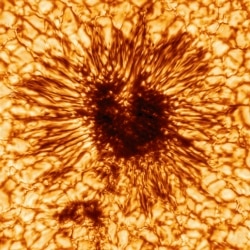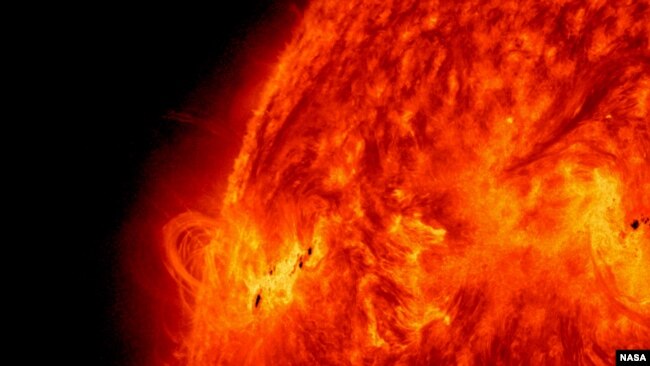難解な内容ですが、とどのつまり
"We suggest you buy a chocolate cake, eat it and wait for the end of the world.” という状況ではないということです。
まさに Oh my God!! 2025年!!
VOAで英語を学びましょう!!
最近の人工衛星の損失で見えた太陽嵐の脅威(和訳)
Threat of Solar Storms Seen with Recent Satellite Loss
Feb 17,2022
スペースX社は最近、太陽嵐により、同社が最近打ち上げた49基の通信衛星のうち少なくとも40基が使用不能になったと発表しました。
同社によると、これらの衛星は2月3日にフロリダ州のケネディ宇宙センターから打ち上げられたと言います。同時期に、米宇宙天気予報センターから”地磁気嵐注意報”がリストアップされました。同センターは、太陽プラズマガスと太陽表面からの電磁波の大規模な爆発が、地球の大気圏に到達する可能性が高いと警告していました。
SpaceX社によると、この嵐により、衛星の低軌道周辺の大気密度が大幅に上昇しました。このため摩擦が生じ、少なくとも40基が使用不能になったのです。
ジョナサン・マクダウェル氏は、ハーバード・スミソニアンの天体物理学者です。同氏は、今回の事件は、1回の地磁気現象による人工衛星の集団的損失としては最大とみられると述べています。
太陽嵐の脅威
科学者たちは、こうした破壊的な太陽嵐がいつ地球上の生命に影響を与えるかわからないと警告しています。磁場やプラズマガスの形でエネルギーを放出するこれらの太陽からの突発は、予測不可能であり、その対策は困難です。
調査によると、地球は1〜2世紀ごとに非常に破壊的な太陽嵐に見舞われています。過去には、これらは主に空を彩る光のショーであり、人類への影響は限定的でした。しかし、現代のテクノロジーは、この太陽嵐によって深刻な影響を受ける可能性があります。
1859年9月に強烈な地磁気嵐が地球を襲ったとき、北米とヨーロッパの電信システムに障害が発生しました。また、通信事業者が電気ショックを受けたという報告もありました。1989年3月の太陽嵐は、カナダのケベック州で停電を引き起こしました。
2003年のハロウィーン・ストームは、軌道上の人工衛星の半分以上に影響を与え、航空業界を混乱させました。また、ヨーロッパの一部では数時間にわたって電気が使えなくなり、南アフリカでは変圧器が破壊されました。
ライムンド・ムシェラー 氏は、スウェーデン・ルンド大学の地質学教授です。氷のサンプルを用いた新しい研究で、約9,200年前のこれまで知られていなかった巨大な太陽嵐が現代に地球を襲った場合、通信システムが破壊されるだろうと結論づけました。
ダニエル・ベイカー氏は、コロラド大学の惑星・宇宙物理学の専門家です。太陽嵐について語るとき、「..政策立案者が本当に対処しなければならないことです 。」と彼は述べています。さらに、「...長期的には、もしもという問題ではなく、いつかという問題です。」とも述べています。
想定される被害
太陽の暴発は、まず電離層—地球の大気と宇宙が交わる場所—と無線通信を混乱させる可能性があります。また、一部の衛星にさらなる摩擦を生じさせ、スペースX社の衛星に起こったような事態を引き起こします。高荷重粒子を持つ嵐はまた、放射性物質である可能性があり、軌道上の宇宙飛行士に危険性を提示しました。
”コロナ質量放出”と呼ばれる太陽表面でのガスと磁場の爆発は、地球の電力システムに過負荷を与え、パイプラインの腐食を加速させる可能性があります。
ルンド大学のムシェラー氏は、「地磁気嵐は、十分に保護されていない場合、実際に変圧器を焼損させる可能性があります」と述べています。
カリフォルニア大学アーバイン校コンピュータサイエンスのサンゲイタ アブドゥ ジョティ助教授は、次のように述べています。彼女は、太陽嵐は北米とヨーロッパを結ぶ長距離通信回線にもダメージを与える可能性があると警告しています。
大規模な太陽嵐は、自動車の運転から飛行機の飛行まで、現代生活に欠かせない全地球測位システム(GPS)衛星を脅かす可能性があります。また、大きな嵐は、オゾン層の破壊を引き起こし、地球の気候に影響を与える可能性があります。
太陽サイクル
ハーバード・スミソニアン大学のマクダウェル氏は、太陽が黒点として知られる磁場活動の11年周期に近づくと、地磁気嵐活動が活発化すると予想しています。
この周期は、2025年7月に最悪になると予測されています。太陽系科学者によれば、過去数世紀の最も活発な周期に比べれば、その強度は低くなると言います。 しかし、一部の政府は、将来起こりうる大嵐による被害への備えをしていないようです。
コロラド大学の専門家ベーカーによれば、あるフランスの女性が、大規模な地磁気嵐にどう備えるべきかについて、フランスの当局に問い合わせたと言います。
彼らは、「チョコレートケーキを買って、それを食べて、世界の終わりを待つことをお勧めします 」と言ったそうです。
Threat of Solar Storms Seen with Recent Satellite Loss
SpaceX recently announced that a solar storm has disabled at least 40 of the 49 communication satellites that it recently launched.
The company said the satellites were launched on February 3 from the Kennedy Space Center in Florida. Around the same time, there was a “geomagnetic storm watch” listed by the U.S. Space Weather Prediction Center. The center warned that a large burst of solar plasma gas and electromagnetic radiation from the sun's surface would likely reach Earth’s atmosphere.
SpaceX said the storm greatly increased atmospheric density around the satellites’ low orbit. This created friction that disabled at least 40 of them.
Jonathan McDowell is a Harvard-Smithsonian astrophysicist. He said that the incident is believed to be the largest collective loss of satellites from a single geomagnetic event.
The threat of solar storms
Scientists are warning that these destructive solar storms could affect life on Earth at any time. These outbursts from the sun, which eject energy in the form of magnetic fields and plasma gas are unpredictable and difficult to prepare for.
Research shows that Earth is hit by a very destructive solar storm every century or two. In the past, these were mainly colorful light shows on the sky with limited effects on humanity. Modern technology, however, can be severely affected by these solar storms.
When an intense geomagnetic storm hit the Earth in September 1859, telegraph systems across North America and Europe failed. Some operators reported receiving electrical shocks. A solar storm in March 1989 caused power failures in Quebec, Canada.
The Halloween Storms of 2003 affected more than half of the orbiting satellites and disrupted aviation. Electrical service was also knocked out in parts of Europe for several hours, and transformers in South Africa were destroyed.
Raimund Muscheler is a geology professor at Lund University in Sweden. In a new study of ice samples, he concluded that a previously unknown, huge solar storm about 9,200 years ago would have destroyed communication systems if it had hit Earth in modern times.
Daniel Baker is an expert in planetary and space physics from the University of Colorado. When talking about solar storms, he said, “… it's something that really needs to be dealt with by policymakers." He added that “… in the longer term, it's not a question of if but when."
Possible damage
The sun outbursts could first disrupt the ionosphere — where the Earth's atmosphere meets space — and radio communications. They also create additional friction on some satellites, which is what happened to SpaceX satellites. The storm with its highly charged particles could also be radioactive and presented a danger to astronauts in orbit.
The gas and magnetic field explosions on the surface of the sun, known as “coronal mass ejection,” could overload Earth’s electrical power systems and speed corrosion of pipelines.
"The geomagnetic storm can actually cause transformers to burn through if they are not adequately protected," said Muscheler of Lund University.
Sangeetha Abdu Jyothi is an assistant professor in the computer sciences at the University of California, Irvine. She warned that solar storms could also damage long-distance communication lines between North America and Europe.
Any major solar storm could threaten Global Positioning System (or GPS) satellites which are critical to modern life from driving cars to flying planes. And a big storm can cause a reduction in the ozone to affect the climate on Earth.
Solar cycles
McDowell of Harvard-Smithsonian expects geomagnetic storm activity to increase as the sun nears its 11-year cycle of magnetic field activity known as sunspots.
The cycle is predicted to be at its worst in July 2025. Solar scientists say the good news is that it will be less intense than the most active cycles of past centuries. However, some governments seem unprepared for possible damage likely to be caused by future major storms.
Baker, the University of Colorado expert said a concerned woman in France contacted officials there for advice on how to prepare for a major geomagnetic storm.
They told her, "We suggest you buy a chocolate cake, eat it and wait for the end of the world.”
Words in This Story
geomagnetic – n. the magnetism of the earth
astrophysics – n. the scientific study of the physical and chemical properties and structures of stars, planets, and other objects in outer space
friction – n. the force that causes a moving object to slow down when it is touching another object
aviation – n. the business or practice of flying airplanes or helicopters
sample – n. a small amount of something that gives you information about the thing it was taken from
corrode – v. to gradually destroy or weaken (something)
adequately – adj. enough for some need or requirement
cycle – n. a set of events or actions that happen again and again in the same order: a repeating series of events or actions


